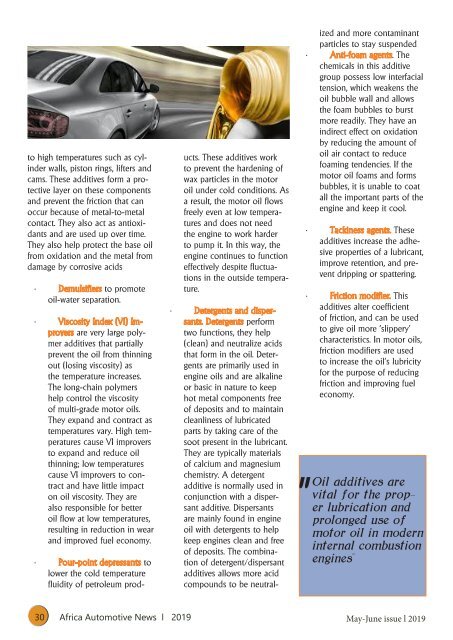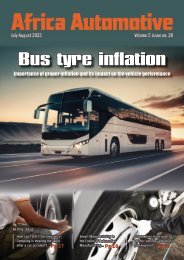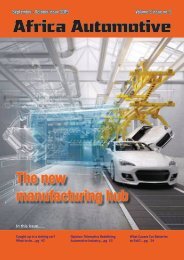Africa Automotive May-June digital issue 2019
Africa Automotive prides itself to be the ONLY Africa’s leading and MOST authoritative magazine for the automotive industry in Africa with printed copies for the automotive industry decision makers in both government, NGO’s and private sector. The Bi-monthly magazine offers cost effective advertising services that get results and improves growth in the auto B2C and B2B sector, keeping an eye on latest technologies in Africa and across the world, the magazine predominately covers the developments in the Africa auto industry.
Africa Automotive prides itself to be the ONLY Africa’s leading and MOST authoritative magazine for the automotive industry in Africa with printed copies for the automotive industry decision makers in both government, NGO’s and private sector. The Bi-monthly magazine offers cost effective advertising services that get results and improves growth in the auto B2C and B2B sector, keeping an eye on latest technologies in Africa and across the world, the magazine predominately covers the developments in the Africa auto industry.
Create successful ePaper yourself
Turn your PDF publications into a flip-book with our unique Google optimized e-Paper software.
to high temperatures such as cylinder<br />
walls, piston rings, lifters and<br />
cams. These additives form a protective<br />
layer on these components<br />
and prevent the friction that can<br />
occur because of metal-to-metal<br />
contact. They also act as antioxidants<br />
and are used up over time.<br />
They also help protect the base oil<br />
from oxidation and the metal from<br />
damage by corrosive acids<br />
• Demulsifiers to promote<br />
oil-water separation.<br />
• Viscosity Index (VI) Improvers<br />
are very large polymer<br />
additives that partially<br />
prevent the oil from thinning<br />
out (losing viscosity) as<br />
the temperature increases.<br />
The long-chain polymers<br />
help control the viscosity<br />
of multi-grade motor oils.<br />
They expand and contract as<br />
temperatures vary. High temperatures<br />
cause VI improvers<br />
to expand and reduce oil<br />
thinning; low temperatures<br />
cause VI improvers to contract<br />
and have little impact<br />
on oil viscosity. They are<br />
also responsible for better<br />
oil flow at low temperatures,<br />
resulting in reduction in wear<br />
and improved fuel economy.<br />
• Pour-point depressants to<br />
lower the cold temperature<br />
fluidity of petroleum products.<br />
These additives work<br />
to prevent the hardening of<br />
wax particles in the motor<br />
oil under cold conditions. As<br />
a result, the motor oil flows<br />
freely even at low temperatures<br />
and does not need<br />
the engine to work harder<br />
to pump it. In this way, the<br />
engine continues to function<br />
effectively despite fluctuations<br />
in the outside temperature.<br />
• Detergents and dispersants.<br />
Detergents perform<br />
two functions, they help<br />
(clean) and neutralize acids<br />
that form in the oil. Detergents<br />
are primarily used in<br />
engine oils and are alkaline<br />
or basic in nature to keep<br />
hot metal components free<br />
of deposits and to maintain<br />
cleanliness of lubricated<br />
parts by taking care of the<br />
soot present in the lubricant.<br />
They are typically materials<br />
of calcium and magnesium<br />
chemistry. A detergent<br />
additive is normally used in<br />
conjunction with a dispersant<br />
additive. Dispersants<br />
are mainly found in engine<br />
oil with detergents to help<br />
keep engines clean and free<br />
of deposits. The combination<br />
of detergent/dispersant<br />
additives allows more acid<br />
compounds to be neutralized<br />
and more contaminant<br />
particles to stay suspended<br />
• Anti-foam agents. The<br />
chemicals in this additive<br />
group possess low interfacial<br />
tension, which weakens the<br />
oil bubble wall and allows<br />
the foam bubbles to burst<br />
more readily. They have an<br />
indirect effect on oxidation<br />
by reducing the amount of<br />
oil air contact to reduce<br />
foaming tendencies. If the<br />
motor oil foams and forms<br />
bubbles, it is unable to coat<br />
all the important parts of the<br />
engine and keep it cool.<br />
• Tackiness agents. These<br />
additives increase the adhesive<br />
properties of a lubricant,<br />
improve retention, and prevent<br />
dripping or spattering.<br />
• Friction modifier. This<br />
additives alter coefficient<br />
of friction, and can be used<br />
to give oil more ‘slippery’<br />
characteristics. In motor oils,<br />
friction modifiers are used<br />
to increase the oil’s lubricity<br />
for the purpose of reducing<br />
friction and improving fuel<br />
economy.<br />
"Oil additives are<br />
vital for the proper<br />
lubrication and<br />
prolonged use of<br />
motor oil in modern<br />
internal combustion<br />
engines'''<br />
30 <strong>Africa</strong> <strong>Automotive</strong> News l <strong>2019</strong> <strong>May</strong>-<strong>June</strong> <strong>issue</strong> l <strong>2019</strong>
















